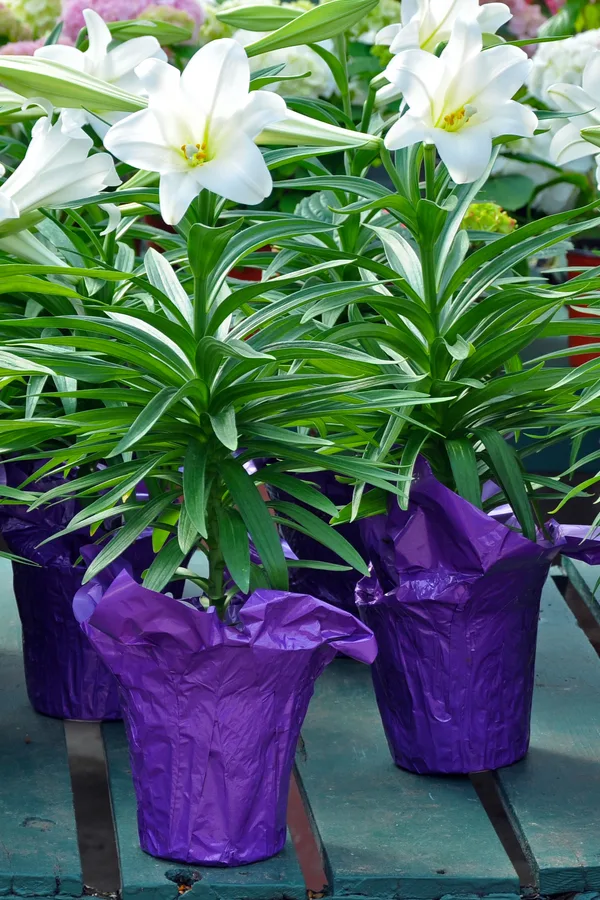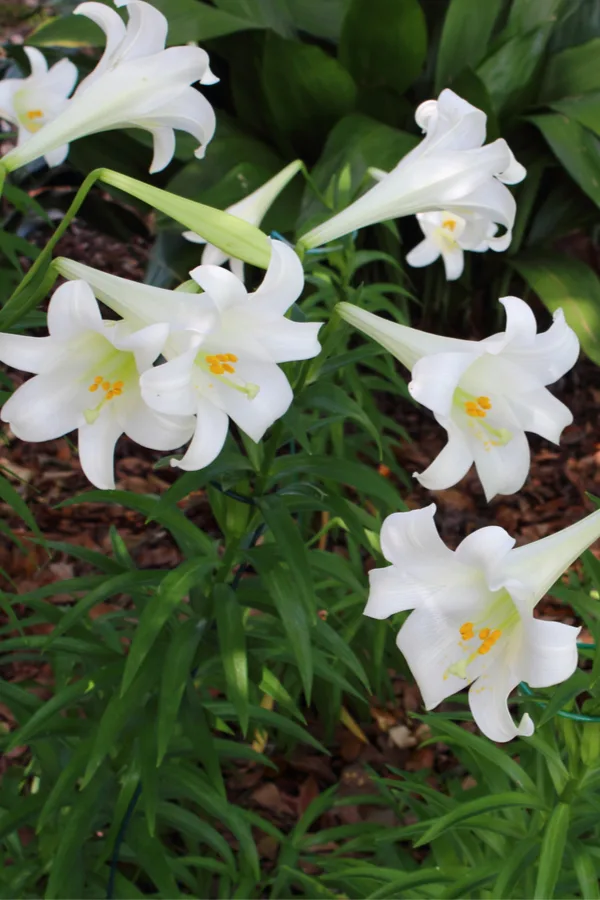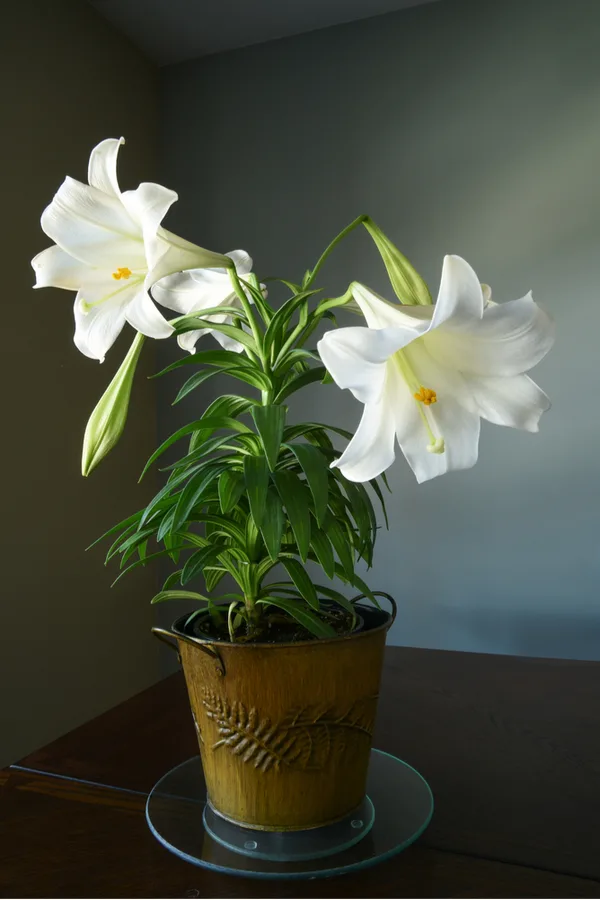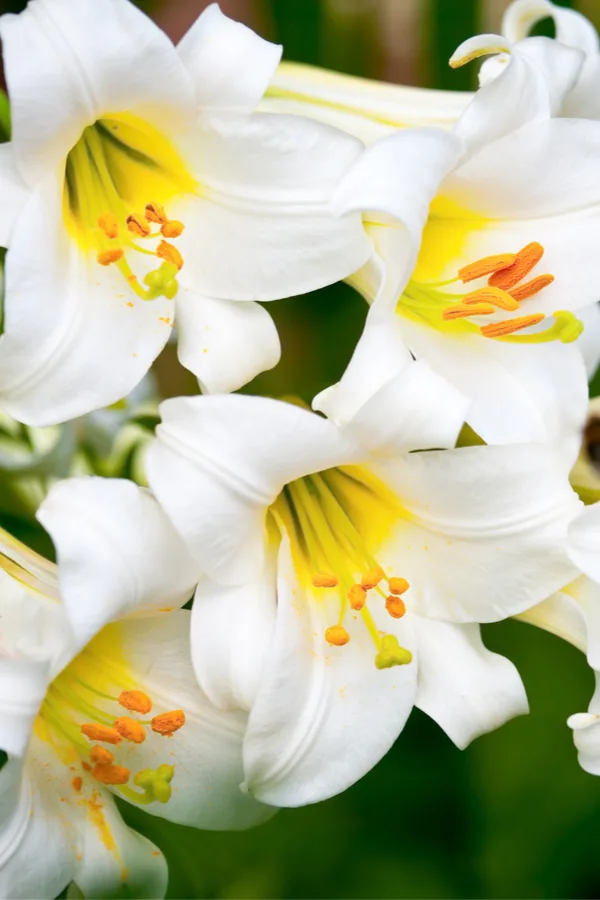So just exactly what do you do with your Easter lily plant after Easter?
Can you keep it alive as a potted plant to bloom again next year? How about planting it outdoors to grow for the summer? And will it survive the winter if you do? The answer for most climates is a resounding yes – to all of the above!
Easter lilies have become one of the most popular spring plants of all. And of course, are synonymous as the go-to plant for blooming during the Easter season. But the funny thing is, they are not actually meant to bloom in the early spring at all, but instead, in the middle of summer.
The bulbous plant is actually a hardy perennial in zones 5 (even 4 with a bit of extra care) and up. And, like many of its lily relatives, is a summer blooming flower whose blooms usually appear anywhere from late June to July.
How The Easter Lily Came To Be
How it came to be a spring-blooming Easter season potted plant is actually a pretty interesting piece of history.
As the story goes, a World War I veteran brought a large collection of the bulbs back with him to the Oregon area following the war. In the process, many learned the bulbs could be potted up over the winter months and then forced to bloom early in the spring, just as the Easter season rolled around.
The rest, as they say is history, as the Easter lily was born! Greenhouses everywhere began to pot the bulbs up over the winter months. And with each passing year, the plant continues to become more and more popular as the go-to decoration or gift for the Easter season.
So if you are one of the many that now have one in your possession, here is a look at how to keep your potted plant alive for many years to come. Inside or outside!
How To Care For An Easter Lily Plant After Easter – Inside Or Outside!
Planting A Lily Outdoors – Preparing A Potted Lily For Outside Life
Lilies are wonderful accent plants for flowerbeds. Their beautiful green foliage and spiked growth make excellent companion plants for many perennials.
Because potted lilies have been accustomed to the warmth and coziness of the indoors, it’s important to first prepare them for outdoor life. Much like with seedlings, a lily needs to be “hardened off” before planting outdoors.
Begin by removing any decorative wrapper your plant might have. The shiny foil wrappers can actually keep too much moisture in. This can also prevent the plant from getting enough oxygen as well.

Next, to help prepare for outdoor life, begin to set your plant outside in a protected area on warmer days. Gradually begin to keep the plant outdoors overnight as the worry of overnight frost or freeze subsides. Once the threat of frost has passed, it’s time to get your plant in the ground.
How To Plant Your Lily Outdoors
Lilies prefer a sunny location that receives at least 6 to 8 hours of direct sunlight each day. A bit of shade, either in the morning or evening is more than fine as long as the plant receives enough light.
Lily bulbs perform best in nutrient-filled, well-draining soil. Dig a hole down to a depth of about 8 inches, and amend the planting hole with plenty of compost. Fill the bottom of the hole with 2″ of compost and plant the lily down in the hole so that the bulb is about 6 inches below the surface of the soil.
Fertilizing at this point is not necessary. Lilies in general do not need a lot of additional nutrients. You can in subsequent years apply a bit of all-purpose organic fertilizer to the plant’s base in the early spring before it blooms, but it is usually not necessary for the plant to set blooms each year.
What is necessary is mulching the lilies to help insulate the plant’s roots and keep moisture below the soil. A 3 to 4 inch layer of mulch around the plant is more than enough to do the trick.

Water the plant in after transplanting, and every few days for the first few weeks to help the bulb establish in the soil. Once the plant has settled in, it will rarely if ever need watering. Lilies tend to be extremely drought tolerant, and the Easter lily is not an exception to that rule.
In an outdoor setting, most lilies will grow and bloom to a height of around 3 feet. For spacing needs, allow at least 18 inches around the plant for full growing capacity.
Long Term Care
One of the best aspects of planting your Easter lilies outdoors is the ease of long term care. Much like with the common daylily, they are actually quite easy to maintain.
As the plant foliage dies back in the fall, cut the foliage back to a few inches above the ground. It is a good idea to re-mulch the base of plants in the early fall to help protect the bulbs over winter. This is especially important if you live the cooler winter climates of Zone 4.
After a few years of growth, plants can be dug up and divided into additional plants. This will not only help promote healthier growth, but keep the plants blooming stronger as well. Plants can be dug up and divided in late summer after they have finished blooming. This will allow enough time for them to re-establish before winter sets in.
Keeping Your Easter Lily As A Potted Plant
You can also, of course, also keep your Easter lily as a potted plant. They are perfect for brightening up porches and patios in the spring and summer, and bringing back indoors for the winter months to add even more interest. It should be noted that it is a bit more difficult for indoor plants to bloom each year.

Once the plant has completed it’s bloom, begin by removing any foil or special covering. Again, this can keep plants from draining properly and getting proper air.
The key to indoor growth is to keep your lily in bright, indirect lighting. Avoid rooms that are extremely hot or cold. An indoor lily will grow best in temperatures from 65 to 75 degrees. As spring and summer approach, a well-lit porch or patio is perfect for strong, healthy growth.
The biggest concern with potted plants is to be sure the bulb has plenty of soil space to maintain healthy growth. Many plants initially arrive in small containers, so replanting may be necessary to keep the plant happy and healthy. Use an all-purpose potting soil that drains for replanting.
Getting Indoor Easter Lilies To Bloom Again
As for getting your lilies to bloom in time for Easter, it is a bit tricky. You will need to chill your plant in the early months of January and February to force early blooms. This process starts by placing in a cool room or basement with indirect lighting. Select a room that chills to about 55 to 60 degrees, but does not freeze or get near freezing.
Check Out Our Latest Garden Podcast:
Next, bring the plant back into a warmer room with brighter, indirect lighting. Rooms that warm to about 70 degrees are ideal for attempting to force blooms. It won’t always work for potted Easter lilies, but it certainly gives them their best chance!
Here is to keeping your Easter lily plant alive and well the whole year round – indoors or out! Happy Gardening, Jim and Mary.
Jim and Mary Competti have been writing gardening, DIY and recipe articles and books for over 15 years from their 46 acre Ohio farm. The two are frequent speakers on all things gardening and love to travel in their spare time.
As always, feel free to email us at thefarm@owgarden.com with comments, questions, or to simply say hello! You can sign up for our free email list in the subscribe now box in the middle of this article. Follow us on Facebook here : OWG Facebook. This article may contain affiliate links.

